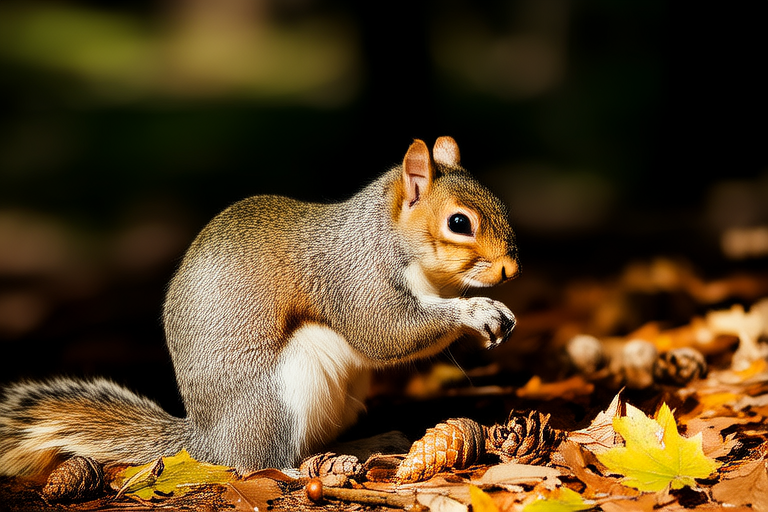Adventures in Nut Hunting: A Day in the Life of Your Local Squirrel
In the bustling heart of every city park, suburban backyard, or sprawling forest, there exists a tiny but mighty creature that epitomizes survival and adaptation. The squirrel, a common sight to many, is more than just a playful critter darting between trees; it’s a master of its environment, navigating through seasons, predators, and urban landscapes with remarkable skill. This article delves into the daily adventures of your local squirrel, offering a detailed look at its activities, challenges, and unique behaviors.
The Dawn Patrol
The day begins before the first light, as squirrels emerge from their cozy nests nestled high in the branches. With the sun still below the horizon, these nocturnal explorers set out on their morning patrol. Their keen eyes scan the ground for any signs of danger or opportunity. This early hour is crucial, as it allows them to establish territory and check for new food sources without the competition from other animals that are still asleep.
Once the sky brightens, the squirrel’s focus shifts to the task at hand: finding food. Acorns, walnuts, and hazelnuts are the primary targets, but they’re also opportunistic eaters, scavenging seeds, berries, and even insects when necessary. Their dexterous paws and sharp claws enable them to dig through leaves and soil in search of buried treasures left over from previous hunts.
Nut Hunting Techniques
One of the most fascinating aspects of a squirrel’s life is its methodical approach to nut hunting. They use a variety of techniques to locate hidden caches, relying heavily on their exceptional sense of smell and memory. Some squirrels bury nuts singly, while others prefer to create large caches in one place, often under the cover of dense vegetation to protect them from theft.
When storing nuts for winter, squirrels engage in what’s known as scatter hoarding. This strategy involves hiding multiple small caches across their territory rather than one large one. By doing so, they reduce the risk of losing all their reserves to a single predator or competitor. Each cache is marked with subtle visual cues or scent markers, allowing the squirrel to remember its location even months later.
Seasonal Changes
The arrival of autumn brings about significant changes in a squirrel’s routine. As deciduous trees shed their leaves, acorns and nuts become abundant, providing ample food for the coming months. Squirrels work tirelessly during this period, collecting and burying as many nuts as possible. However, not all nuts are destined to be eaten; some will sprout and grow into new trees, contributing to the forest’s regeneration.
Winter poses different challenges, with colder temperatures and less available food. During this time, squirrels rely heavily on their stored caches and adapt by becoming more active during warmer periods of the day. They may also venture into urban areas where bird feeders offer easy access to supplemental food sources. In contrast, spring sees a shift towards gathering fresh buds, flowers, and young shoots, complementing their dwindling supply of cached nuts.
Challenges in Urban Settings
For many squirrels, adapting to life in an urban environment requires ingenuity and resilience. Cities present both opportunities and dangers, with an abundance of human-provided food sources alongside increased risks from traffic and domestic pets. Squirrels have learned to navigate sidewalks, cross streets cautiously, and even climb buildings in pursuit of sustenance.
One notable adaptation observed among urban squirrels is their ability to exploit human-altered landscapes. They frequently visit parks, gardens, and backyards in search of birdseed, discarded snacks, or fallen fruit. While this can lead to conflicts with humans over shared resources, it also highlights the flexibility and resourcefulness of these small mammals.
Predator Avoidance
Despite their agility and intelligence, squirrels remain vulnerable to various predators, including hawks, owls, foxes, and domestic cats. To avoid becoming prey, they employ several defensive strategies. These include staying alert for signs of danger, quickly climbing trees or jumping onto roofs, and using their bushy tails as both a rudder for steering and a warning flag to signal potential threats.
Social interactions play a vital role in predator avoidance as well. Squirrels often vocalize when sensing danger, alerting nearby individuals to the presence of a threat. This cooperative behavior helps strengthen community bonds and increases overall safety within the group.
Local Adaptations
Depending on the region, squirrels exhibit specific adaptations tailored to their local environments. For instance, red squirrels found in northern forests have thicker coats suited for colder climates, while ground squirrels in arid regions develop burrowing habits to escape extreme heat. In coastal areas, certain species may incorporate marine plants into their diets due to limited terrestrial options.
Urbanization has led to additional modifications, such as shorter tails in some populations, which may help prevent entanglement in fences or wires. Additionally, squirrels living near airports have been observed adopting quieter behaviors to avoid detection by security systems.
Conclusion
A day in the life of your local squirrel reveals a world full of challenges and triumphs, showcasing the incredible adaptability and resilience of these small creatures. From dawn patrols to nut hunting expeditions, each moment contributes to their survival and success within their ecosystem. Understanding the intricate details of a squirrel’s daily existence not only enriches our appreciation for nature but also underscores the importance of preserving habitats that support such diverse wildlife.
